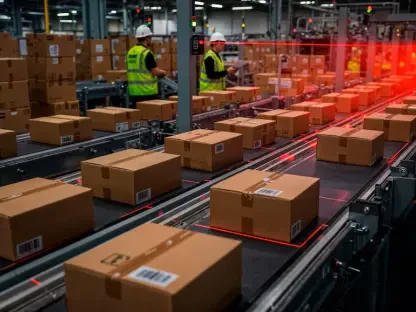The rail industry is undergoing a significant transformation, marked by innovative initiatives focusing on infrastructure expansion and employee engagement. Leading the charge are Union Pacific (UP), BNSF Railway, and CSX Transportation, each contributing to the evolving landscape through strategic developments and workforce recognition. These endeavors reflect a broader trend within the industry aimed at improving operational efficiency, enhancing service quality, and strengthening employee motivation. This article delves into the recent progress made by these rail companies, shedding light on how they are redefining practices to meet modern demands.
Infrastructure Investments
Union Pacific’s Strategic Developments
Union Pacific’s inauguration of the Capital Area Rail Terminal (CART) in Jefferson City, Missouri, represents a breakthrough in logistical capabilities, fostering regional business growth. The terminal, developed in collaboration with local government entities and economic partnerships, acts as a vital hub for the movement of bulk commodities like aggregates, grain, and plastics. This strategic endeavor underscores the growing importance of regional engagement in infrastructure development, highlighting how such initiatives can enhance supply chain efficiency and bolster local economies. Union Pacific’s commitment extends beyond immediate operational gains, signaling a dedication to fostering long-term industrial growth and economic vitality in the region.
Further emphasizing long-term strategic investments, Union Pacific’s renegotiation of the Moffat Tunnel lease exemplifies the company’s dedication to infrastructure development. This historic lease adjustment not only guarantees continued freight operations but also establishes provisions for integrating future passenger rail services, showcasing a forward-thinking approach to transportation. By revising agreements dating back to 1926, Union Pacific sets a precedent for other companies, illustrating how strategic partnerships can facilitate expansive infrastructure goals. The integration of freight and passenger operations through such collaborative frameworks indicates a supportive trend towards developing comprehensive transportation networks that significantly benefit regional economies.
Collaborative Partnerships
Union Pacific’s partnership initiatives highlight the increasing reliance on public-private cooperation to achieve expansive transportation goals. By leveraging shared resources, these collaborations allow for the development of integrated networks that benefit regional economies by improving accessibility and efficiency. These partnerships embody a dynamic approach to solving modern transportation challenges, aligning the interests of public entities and private operators to foster growth. Through such alliances, Union Pacific demonstrates the beneficial impact of cooperation, where joint efforts create synergy that optimizes infrastructure use and enhances service delivery.
Moreover, the trend of public-private collaboration is gaining traction throughout the industry, reflecting the necessity of integrated efforts to address infrastructure demands. These partnerships are crucial as they enable the pooling of expertise, resources, and technology to build robust transportation environments. By engaging with various stakeholders, including government bodies and local communities, rail operators like Union Pacific can tailor infrastructure improvements to meet specific regional needs. The successful implementation of such strategies places Union Pacific at the forefront of transformative practices, showcasing the tangible benefits of collaborative approaches in reshaping the transportation landscape.
Employee Engagement Efforts
BNSF Railway’s Workforce Recognition
BNSF Railway sets a benchmark for employee engagement through its commitment to recognizing workforce contributions, evident in its annual Employees of the Year celebration. This initiative focuses on celebrating safety, service, and team achievements, underscoring the importance of cultivating a motivated company culture. The acknowledgment of individual and team accomplishments not only boosts morale but also reinforces the company’s dedication to operational excellence, safety standards, and service quality. Such recognition is pivotal in encouraging employees to adhere to best practices, fostering a sense of belonging and purpose within the organization.
The positive correlation between effective employee engagement and operational efficiency is further highlighted by BNSF Railway’s recent financial growth. Improvements in operating income and the operating ratio demonstrate how a dedicated workforce can drive positive outcomes. These financial results affirm the necessity of balancing operational efficiency with employee welfare, stressing the importance of adopting a holistic approach to management. By prioritizing human resource development alongside business objectives, BNSF Railway illustrates how investment in employee engagement can result in sustained performance gains, reinforcing the concept that motivated employees are key to achieving long-term success.
CSX Transportation’s Drive Campaign
CSX Transportation’s Drive to Succeed campaign stands as a testament to innovative strategies in employee motivation. By incentivizing attendance and reliability, CSX rewards its staff with significant accolades, such as new vehicles for outstanding contributors. This approach effectively strengthens organizational trust, encouraging employees to maintain high service and safety standards. The campaign exemplifies how recognition of punctuality and consistent performance can enhance not only individual motivation but also overall service quality, contributing to a culture of reliability and dedication within the organization.
By encouraging reliability and consistency, CSX supports a work environment where employees strive for excellence, aligning with broader industry efforts to enhance workforce motivation. This initiative underscores the critical role of employee welfare in driving organizational efficiency and reliability, promoting a culture where workers are valued for their consistent dedication. Through such efforts, CSX Transportation reaffirms its commitment to fostering an engaged and responsible workforce, recognizing that these attributes are integral to maintaining operational effectiveness and customer satisfaction in the face of growing industry demands.
Holistic Industry Transformation
Synthesizing Railroads’ Initiatives
The collective efforts of Union Pacific, BNSF Railway, and CSX Transportation paint a cohesive narrative within the rail industry, highlighting the balance between infrastructural advancements and employee-focused strategies to drive operational success. These initiatives exemplify how strategic investments in infrastructure coupled with robust employee engagement plans can sustain future growth. By addressing both technological and human resource needs, these companies position themselves as pivotal players in redefining operational paradigms and adapting to the trends in modern transportation requirements. Their approaches illustrate the symbiotic relationship between advanced logistical solutions and motivated personnel in reshaping the rail industry’s landscape.
The holistic integration of these strategies underscores a unified approach within the rail industry, where innovation in infrastructure and employee recognition are intertwined to achieve comprehensive results. Union Pacific, BNSF, and CSX have demonstrated that a balanced focus on these key components is essential for navigating the complexities of the transportation sector. Their initiatives set a benchmark for the industry, emphasizing how cohesive strategies that marry logistical advancements with workforce empowerment lead to enhanced service quality and operational success, effectively positioning them for sustained growth and high performance.
The Role of Strategic Planning
The rail industry is experiencing a notable transformation fueled by innovative endeavors that concentrate on expanding infrastructure and enhancing employee involvement. Leading companies such as Union Pacific (UP), BNSF Railway, and CSX Transportation are at the forefront of this evolution, each making significant contributions through strategic initiatives and emphasizing workforce recognition. These movements are part of a broader trend within the industry focused on bolstering operational efficiency, improving service quality, and boosting employee morale. Through various actions, these rail companies are reshaping traditional practices to align with modern requirements, showcasing how they adapt to contemporary challenges. The emphasis extends beyond mere infrastructure upgrades; it encompasses fostering a supportive and motivating work environment for employees, highlighting a comprehensive approach to industry advancement that marries technology with human capital. This reflection reveals an ambitious journey toward meeting future demands and setting new standards for rail operations.








